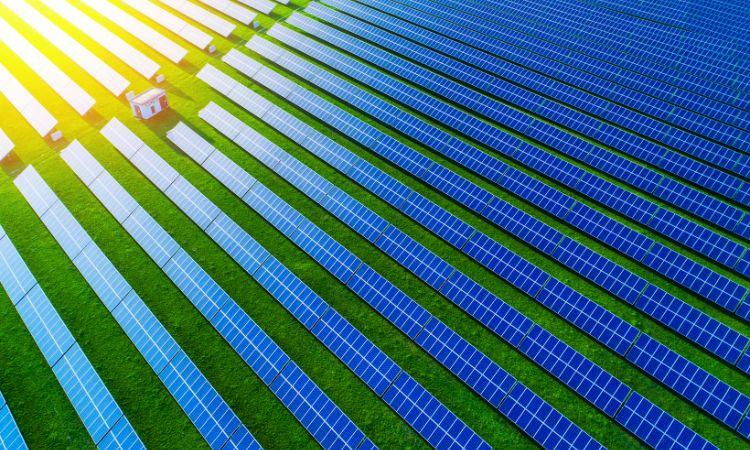The global solar energy market size reached nearly 191.0 GW in 2022. The market is assessed to grow at a CAGR of 7.4% between 2023 and 2028, reaching around 300.8 GW by 2028. This remarkable growth underscores the pivotal role that solar energy plays in our transition to a more sustainable and environmentally friendly energy landscape. One significant contributor to this expansion is the proliferation of solar farms, large-scale installations designed to harness sunlight and convert it into clean electricity.
In this blog post, we will delve into the intricate world of solar farms, focusing specifically on the economics that drive their development. Solar farms are not just a means of harnessing renewable energy; they are also thriving business ventures with unique financial considerations. Understanding the economic aspects of solar farms is crucial for investors, developers, and policymakers alike, as it helps us comprehend the true value and potential of solar energy on a large scale.
II. The Business Case for Solar Farms
Exploring the Motivations
To embark on our exploration of the economics of solar farms, let’s begin by understanding the motivations that drive investments in these sprawling fields of solar panels.
1. Clean Energy Generation: One of the primary motivations is the generation of clean, renewable energy. Solar farms contribute significantly to reducing greenhouse gas emissions, making them a valuable asset in the fight against climate change.
2. Energy Independence: Solar farms offer a degree of energy independence. By generating electricity on-site, businesses and communities can reduce their reliance on traditional energy sources and the associated price fluctuations.
3. Financial Incentives: Governments and utilities often provide financial incentives, including tax credits and rebates, to encourage the development of solar farms. These incentives can significantly improve the economic feasibility of solar projects.
4. Revenue Generation: Solar farms can generate substantial revenue through the sale of electricity, Renewable Energy Certificates (RECs), and other incentives. Many businesses and investors see solar farms as profitable ventures.
Advantages Over Other Renewable Sources
Solar farms offer several advantages over other renewable energy sources, making them an attractive option for sustainable energy generation.
- Solar energy is abundant and widely distributed, making it accessible in various locations.
- Solar panels have a relatively low environmental impact during their operational phase.
- Solar farms can be deployed quickly, with shorter construction times compared to some other renewable energy projects.
III. Project Financing
Various Financing Options
Solar farm development requires substantial upfront capital investment. To make solar projects economically viable, developers often explore various financing options.
1. Debt Financing: Borrowing money from banks or financial institutions is a common way to finance solar farm projects. Debt financing allows developers to spread the upfront costs over a more extended period, reducing immediate financial strain.
2. Equity Financing: Investors can provide equity capital in exchange for ownership stakes in solar farms. This option shares the financial risk and rewards between investors and developers.
3. Power Purchase Agreements (PPAs): PPAs are contracts in which a third party agrees to purchase electricity from a solar farm at a predetermined price over a specified period. These agreements provide a steady revenue stream, making solar farm projects more attractive to investors.
4. Government Incentives: Government incentives, such as tax credits and grants, can significantly reduce the financial burden of solar farm development. These incentives often require compliance with specific renewable energy targets and regulations.
Role of Financial Modeling
Financial modeling plays a crucial role in solar farm development. Developers use complex financial models to assess project feasibility, predict future cash flows, and evaluate potential returns on investment (ROI). Accurate financial modeling helps developers make informed decisions and secure financing.
IV. Land Acquisition and Site Selection
Choosing the Right Location
Selecting the optimal location for a solar farm is a critical decision with significant economic implications. Several factors influence site selection:
1. Solar Resource: The amount of sunlight a location receives directly impacts a solar farm’s energy production. Areas with higher solar irradiance are generally more favorable.
2. Land Availability: The availability and cost of land are essential considerations. Solar farms require large expanses of relatively flat, unshaded land.
3. Proximity to Infrastructure: Access to electrical grids and infrastructure is vital. Being near existing power lines can reduce the cost of grid connection.
4. Environmental Considerations: Developers must assess the environmental impact of a solar farm, including potential habitat disruption and visual aesthetics.
5. Regulatory Environment: Understanding local zoning laws, permitting requirements, and environmental regulations is crucial for successful project development.
Negotiating Land Agreements
Developers often negotiate land agreements or leases with landowners. These agreements stipulate the terms and conditions of land use, rental payments, and responsibilities for site maintenance. Favorable land agreements can significantly impact a solar farm’s economic viability.
V. Construction and Installation Costs
Breaking Down the Costs
The construction and installation phase is a significant cost driver in solar farm development. Key components include:
1. Solar Panels: The cost of solar panels, also known as photovoltaic (PV) modules, represents a substantial portion of the project’s budget. Advances in solar panel technology continue to impact costs and efficiency.
2. Inverters: Inverters convert the direct current (DC) electricity generated by solar panels into alternating current (AC) for use in electrical grids. Inverter costs vary based on capacity and technology.
3. Mounting Structures: Mounting structures, including racking and tracking systems, support and orient solar panels. The type of mounting structure used can impact installation costs.
4. Electrical Components: Electrical components, such as transformers, switches, and wiring, are essential for connecting solar panels to the grid.
5. Labor and Installation: Labor costs include expenses related to site preparation, panel installation, and electrical work. Skilled labor is crucial for ensuring the efficient operation of a solar farm.
Cost Optimization
Developers employ various strategies to optimize construction and installation costs, such as:
- Procuring components at competitive prices through bulk purchases or partnerships.
- Efficient project management and logistics to reduce labor costs.
- Leveraging economies of scale by developing larger solar farms.
VI. Revenue Generation
Sources of Revenue
Solar farms generate revenue through various channels, making them economically sustainable ventures. Some of the primary revenue sources include:
1. Electricity Sales: The sale of electricity to utilities or consumers is a significant source of revenue. Revenue generated from electricity sales can vary based on the terms of power purchase agreements (PPAs) and prevailing electricity prices.
2. Renewable Energy Certificates (RECs): Solar farms can earn RECs for generating clean, renewable energy. These certificates can be sold to utilities and businesses looking to meet renewable energy goals and compliance requirements.
3. Tax Benefits: Solar farm developers may benefit from tax incentives and credits, reducing overall project costs and improving the project’s financial outlook.
4. Feed-In Tariffs and Net Metering: Some regions offer feed-in tariffs or net metering programs, allowing solar farm owners to sell excess electricity to the grid at favorable rates or receive credit for surplus energy.
5. Ancillary Services: Solar farms can provide ancillary services, such as grid stabilization and frequency regulation, in exchange for additional revenue.
Power Purchase Agreements (PPAs)
PPAs play a pivotal role in revenue generation for solar farms. These contractual agreements outline the terms of electricity sales, including pricing, duration, and other relevant terms. PPAs provide revenue certainty and mitigate price fluctuations in the electricity market.
VII. Ongoing Operation and Maintenance
Ongoing Costs
While solar farms generate revenue, they also incur ongoing operational and maintenance costs. These costs include:
1. Routine Maintenance: Regular inspections, cleaning, and maintenance are essential to ensure optimal panel performance and longevity.
2. Monitoring Systems: Solar farms often feature advanced monitoring systems that track energy production and identify potential issues. The cost of monitoring equipment and services is an ongoing expense.
3. Repairs and Upgrades: Addressing equipment failures or performing necessary upgrades is part of the ongoing maintenance cost.
4. Land Lease Payments: Payments to landowners as per lease agreements are recurring costs for the duration of the lease.
Maximizing Energy Production
Efficient operation and maintenance practices are essential for maximizing energy production and revenue. Solar farm owners often invest in advanced monitoring and maintenance technologies to optimize performance.
VIII. Return on Investment (ROI)
Calculating ROI
Return on Investment (ROI) is a critical metric for assessing the economic viability of solar farm projects. ROI calculations take into account the initial investment, ongoing costs, and revenue generation over time.
1. Initial Investment: This includes the costs of land acquisition, construction, installation, and other startup expenses.
2. Ongoing Costs: Ongoing operational and maintenance costs are subtracted from revenue to calculate net income.
3. Revenue Generation: Revenue from electricity sales, RECs, and other sources is considered.
Factors Influencing ROI
Several factors influence the ROI timeline and overall financial performance of solar farm projects:
1. Location: Solar irradiance, local electricity prices, and access to incentives impact revenue generation.
2. Financing Terms: The terms of debt and equity financing, including interest rates, affect the cost of capital.
3. Government Incentives: The availability and size of government incentives and tax benefits can significantly impact ROI.
4. Energy Prices: Electricity prices in the region where the solar farm operates can impact revenue.
5. Efficiency and Maintenance: The efficiency of solar panels and the effectiveness of maintenance practices influence energy production and revenue.
6. Market Conditions: Market conditions, including the demand for renewable energy and competition, can impact revenue and profitability.
Case Studies
To illustrate the concept of ROI in solar farm economics, let’s examine a few hypothetical case studies that demonstrate different ROI scenarios:
Case Study 1: Fast ROI with Government Incentives This case study explores a solar farm project that benefits from generous government incentives, resulting in a rapid ROI timeline.
Case Study 2: Steady ROI with Commercial PPAs In this scenario, a solar farm generates steady revenue through long-term commercial power purchase agreements (PPAs), leading to a consistent ROI.
Case Study 3: Competitive ROI in a Deregulated Market This case study examines a solar farm operating in a competitive, deregulated electricity market, where ROI is influenced by market dynamics.
IX. Risks and Mitigation Strategies
Identifying Common Risks
Solar farm investments carry inherent risks that can impact the project’s economic performance. Common risks include:
1. Market Price Risk: Fluctuations in electricity prices can affect revenue.
2. Technology Risk: Solar panel technology and equipment may become outdated or suffer from technical issues.
3. Regulatory and Policy Risks: Changes in government incentives and regulations can impact project economics.
4. Environmental Risks: Extreme weather events and environmental factors can affect energy production and equipment.
5. Operational Risks: Equipment failures, maintenance issues, and unexpected downtime can disrupt revenue generation.
Strategies for Risk Mitigation
Developers and investors employ various strategies to mitigate risks and enhance the economic viability of solar farm projects:
1. Diversification: Diversifying investments across multiple projects or regions can reduce risk exposure.
2. Insurance: Insurance policies can protect against various risks, including equipment failures and natural disasters.
3. Legal and Regulatory Expertise: Staying informed about changing regulations and having legal expertise can help navigate regulatory risks.
4. Technology Upgrades: Investing in technology upgrades and regular maintenance can reduce the risk of equipment failure.
X. Future Trends and Innovations
Emerging Trends
The world of solar farm economics is continually evolving, influenced by emerging trends and innovations:
1. Energy Storage Solutions: The integration of energy storage technologies, such as batteries, is becoming more prevalent in solar farm projects. Storage solutions enhance energy reliability and grid stability, potentially increasing revenue streams.
2. Advanced Monitoring and AI: Advanced monitoring systems and artificial intelligence (AI) are being used to optimize solar farm operations, reduce maintenance costs, and enhance overall performance.
3. Hybrid Energy Systems: Combining solar energy with other renewable sources, such as wind or geothermal, is a growing trend that can provide a more consistent energy supply.
4. Decentralized Energy: Decentralized energy systems, where energy is generated and consumed locally, offer economic benefits, including reduced transmission and distribution costs.
5. Community Solar: Community solar projects allow individuals and communities to share in the benefits of solar energy generation, fostering local support and participation.



